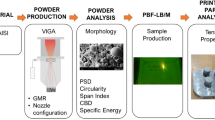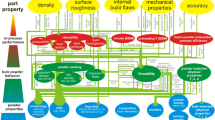Abstract
The purpose of this report is to go through a step-by-step procedure to try to determine and optimize one of the most critical parameters of the powder forging process (PF), that is,preform temperature.
Similar content being viewed by others
References
Kobe Steel Ltd., Powder Consolidation Technology and Kobe Powder Forging Line.
Sintermetallwerk Krebsoge GMBH, Status of Powder Forging at Krebsoge,Metal Powder Report, Vol. 40, No. 9 (1985), pp. 490–494.
A. Badawy, Trip Report-GKN PF Operation, NDH Visit to Europe, 1985.
K. Imahashi, C. Thumuki, and I. Nagare, Development of Powder Forged Connecting Rods, SAE Technical Paper, October, 1984.
G. Bockstiegel and M. Stromgren, “Hoeganaes Automatic PM Forging System, Concept and Application”, SAE Technical Paper, February, 1979.
K. Morimoto, K. Ogata, T. Yamamura, T. Yukawa, T. Saga, N. Yamada, and N. Sekiguchi, Transmission Spur Gear by Powder Forging, Report by Honda and Kobe, SAE Technical Paper, October, 1984.
G.F. Bocchini, The Influence of Porosity on the Characteristics of Sintered Materials,The International Journal of Powder Metallurgy, Vol. 22, No. 3, pp. 185–202, July 1986.
S. Mocarski and P.C. Eloff, Equipment Considerations for Forging Powder Preforms, pp. 51–67,New Perspectives in Powder Metallurgy: 6, Forging of Powder Metallurgy Preforms, Metal Powder Industries Federation, New York, 1973.
F. Lally, I. Toth, and J. Dibenedetto, Forging of Steel Powder Products, pp. 103–130,New Perspectives in Powder Metallurgy: 6, Forging of Powder Metallurgy Preforms, Metal Powder Industries Federation, New York, 1973.
S.M. Kaufman and S. Mocarski, The Effect of Small Amounts of Residual Porosity on the Mechanical Properties of P/M Forgings, pp. 131–142,New Perspectives in Powder Metallurgy: 6, Forging of Powder Metallurgy Preforms, Metal Powder Industries Federation, New York, 1973.
R.B. Bargainnier and J.S. Hirschhorn, Forging studies of A Ni-Mo P/M Steel, pp. 229–266,New Perspectives in Powder Metallurgy: 6, Forging of Powder Metallurgy Preforms, Metal Powder Industries Federation, New York, 1973.
J. Niessen, Production Experience in Forging P/M Parts, pp. 357–366,New Perspectives in Powder Metallurgy: 6, Forging of Powder Metallurgy Preforms, Metal Powder Industries Federation, New York, 1973.
A. Badawy, S. Oh, J.J. Park, and M. Ranek, Prediction of Density Distribution of Powder Forged Connecting Rods Using ALPIDP, to be published in ASM’s JMST.
Author information
Authors and Affiliations
Rights and permissions
About this article
Cite this article
Badawy, A. Survey and recommendations on the selection of optimum powder forging temperature. J. Materials Shaping Technology 6, 31–40 (1988). https://doi.org/10.1007/BF02833581
Issue Date:
DOI: https://doi.org/10.1007/BF02833581




